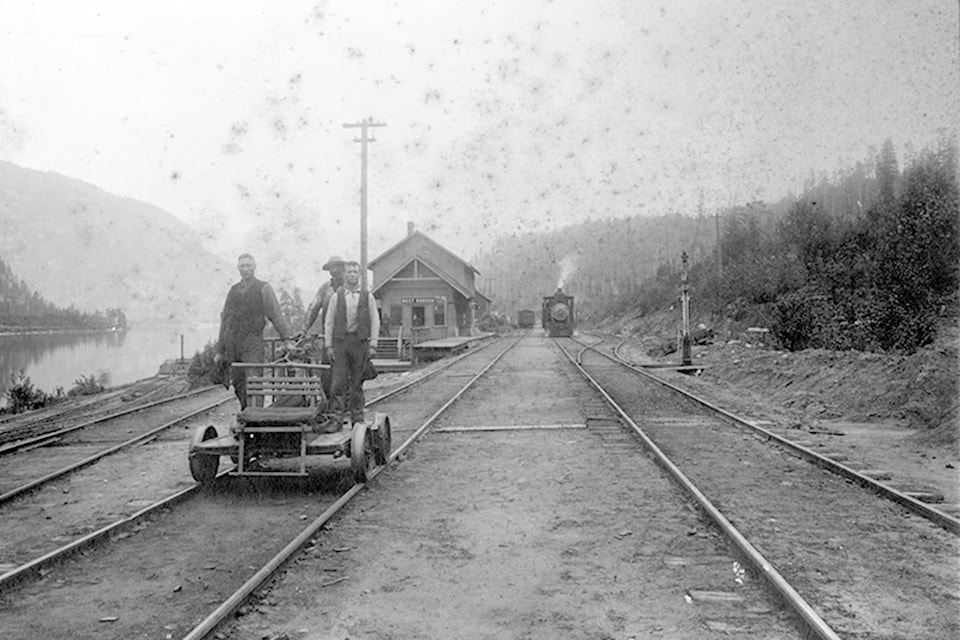Last November my Ormsby Review of Ralph Beaumont’s book Heckman’s Canadian Pacific: A Photographic Journey was published online. It immediately connected me with the book’s author, who congratulated me on grasping his objectives.
His welcome message opened up a new association, for, as Ralph put it, “we both had fallen down the same Heckman rabbit hole.” As Ralph had had a privileged access to all the Heckman records when they were still housed at the CPR Archives, he offered to help me out in my further research. In my review of his book, I had added the local perspective, which he found intriguing. My story on the Castlegar train bridge held the same fascination for him as it had for me, and he regretted not including that Heckman photo in his book.
On the basis of Heckman’s 1901 photographic record, I ventured a guess in my review that the party travelled downhill from the two summits (Farron and Eholt) to make the work easier for his handcar propulsion crew. I could tell in most images the direction the car was facing, as Heckman’s seat was a prominent feature of the front. However, I needed confirmation and a more precise accounting of his movements, which he would have recorded in his field book, that he always labelled ‘Photographic Journey’. When I approached Exporail, where the CPR Archives are now held, his field books for his earlier work could not be found. As Ralph had photographed the pages for his research, he offered to type up the information for his work in our local area. That allowed me to match his negative numbers (he used 8 x 10 glass plates) with the prints that he produced from them when back in Montreal. I also had dates and times the photographs were taken, as well as the camera orientation.
Originally I thought Heckman started at Farron and worked his way westward to Midway (always downgrade) and upon his return filling in his missed downgrade segments as he was heading eastward. I was almost entirely correct, except for one detail. He commenced his work at Farron, but moved eastward, back to West Robson, where he had caught the train for Farron. His reasoning for that, I suspect, was that all the trestles along the Arrow Lake grade could not be done in one day.
This is the itinerary I worked out for his movements. On May 27 he caught the 9:20 train at West Robson, arriving at Farron at 11:03. He took his first photograph at 12:55; some others of note were: Porcupine trestle (13:10), Bull Dog tunnel (14:15), Brooklyn trestle (14:45) and the ‘granite wall’ trestle below Coykendahl (17:25). That was his last photo of the day, due to light limitations. He may have proceeded to West Robson on the 19:28 train, for a return trip on the morning train, or spent the night in the Shields section house.
The sequence to Labarthe was completed on the afternoon of May 28. On May 29 he wandered over to the construction site of the Columbia River bridge and took that one remarkable picture at 11:20, as well as two others in the other direction (towards Castlegar). I would sacrifice my eyeteeth to see those. At 13:00 he took his photo of West Robson station.
On May 30 he again took the train to Farron, which he photographed at 12:20. Then he set out, taking his first photo of the downhill grade at Paulson tunnel at 13:30. His last photo of the day was Cascade station (16:15).
On May 31 he proceeded by handcar along the Gilpin flats into Grand Forks, photographing the remaining four Kettle River bridges. He then caught the 13:00 train for Eholt, where he arrived at 13:55. Photographs on the downhill run ended at 17:45 east of Midway, where he spent the night. On June 1 he photographed Midway station with a group of children (10:15). On the following day, he caught the train back uphill to Eholt, from where he set out the next morning to photograph the downhill run into Grand Forks. This particular ‘photographic journey’ produced 69 plates (numbers 76 to 144). Plates 50 to 75 were devoted to the Nelson – Robson line over two days (May 22 & 23). Temporal gaps most likely indicate times spent in his portable darkroom processing his negatives to ensure they were satisfactory.
Most of the Heckman negatives have disappeared and his original prints in the albums have been degraded by time. Beaumont had permission to remove those blemishes for publication. For some reason, Heckman’s most important photograph locally, of the Columbia River crossing, remained pristine.
My review of Beaumont’s book is at https://bcbooklook.com/2017/11/09/what-the-heckman/
